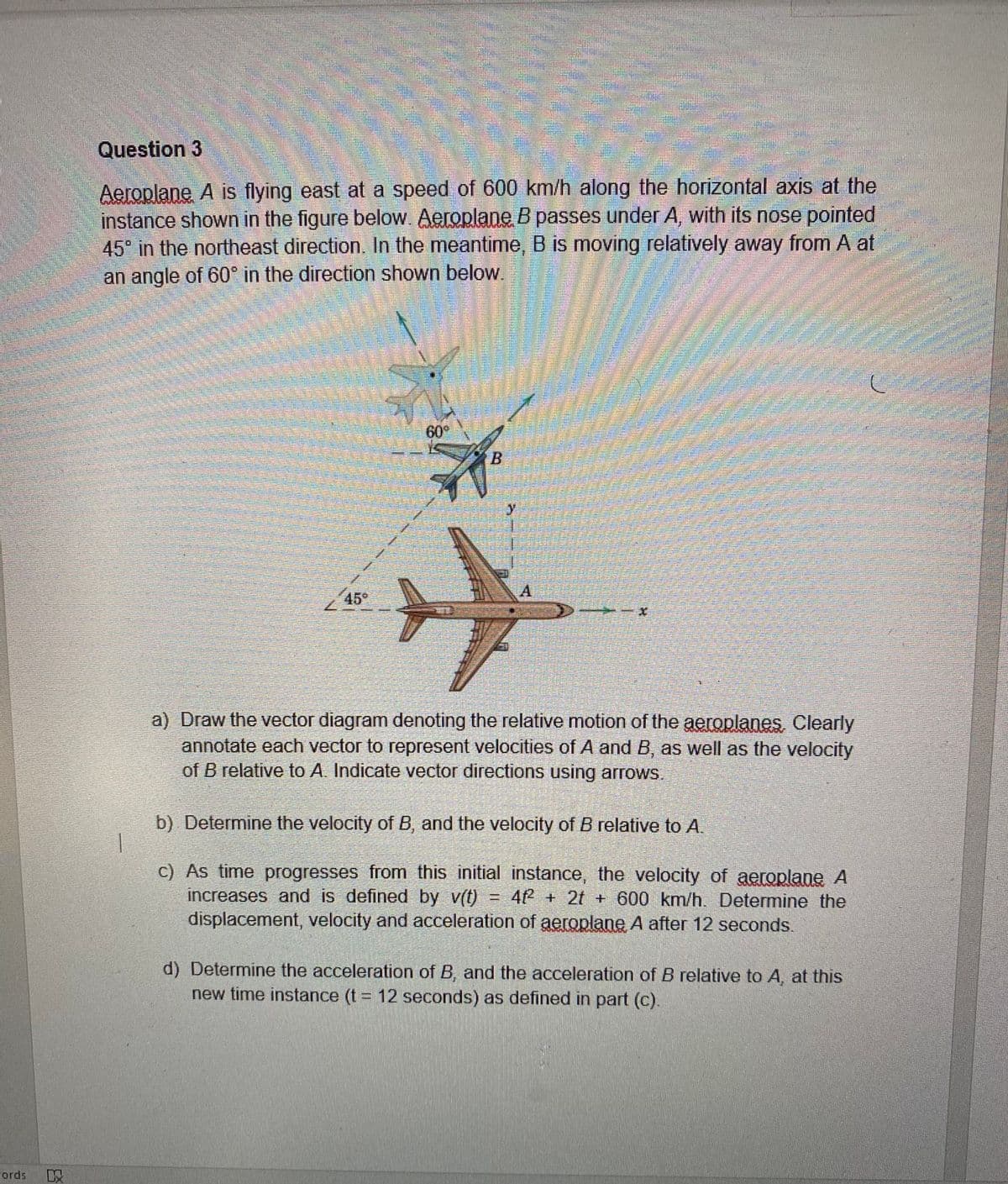Aeroplane A is flying east at a speed of 600 km/h along the horizontal axis at the instance shown in the figure below. Aeroplane B passes under A, with its nose pointed 45° in the northeast direction. In the meantime, B is moving relatively away from A at an angle of 60° in the direction shown below. 60° y 45° a) Draw the vector diagram denoting the relative motion of the aeroplanees Clearly annotate each vector to represent velocities of A and B, as well as the velocity of B relative to A. Indicate vector directions using arrows. b) Determine the velocity of B, and the velocity of B relative to A. c) As time progresses from this initial instance, the velocity of aeroplane A increases and is defined by v(t) = 4P + 2t + 600 km/h. Determine the displacement, velocity and acceleration of aeroplane A after 12 seconds. d) Determine the acceleration of B, and the acceleration of B relative to A, at this new time instance (t = 12 seconds) as defined in part (c).
Aeroplane A is flying east at a speed of 600 km/h along the horizontal axis at the instance shown in the figure below. Aeroplane B passes under A, with its nose pointed 45° in the northeast direction. In the meantime, B is moving relatively away from A at an angle of 60° in the direction shown below. 60° y 45° a) Draw the vector diagram denoting the relative motion of the aeroplanees Clearly annotate each vector to represent velocities of A and B, as well as the velocity of B relative to A. Indicate vector directions using arrows. b) Determine the velocity of B, and the velocity of B relative to A. c) As time progresses from this initial instance, the velocity of aeroplane A increases and is defined by v(t) = 4P + 2t + 600 km/h. Determine the displacement, velocity and acceleration of aeroplane A after 12 seconds. d) Determine the acceleration of B, and the acceleration of B relative to A, at this new time instance (t = 12 seconds) as defined in part (c).
International Edition---engineering Mechanics: Statics, 4th Edition
4th Edition
ISBN:9781305501607
Author:Andrew Pytel And Jaan Kiusalaas
Publisher:Andrew Pytel And Jaan Kiusalaas
Chapter1: Introduction To Statics
Section: Chapter Questions
Problem 1.47P: A rifle at A is fired at a target at B. If the speed of the bullet is 1400 ft/s, determine the...
Related questions
Question
Please can you answer with full working out and label each part

Transcribed Image Text:Question 3
Aeroplane A is flying east at a speed of 600 km/h along the horizontal axis at the
instance shown in the figure below. Aeroplane B passes under A, with its nose pointed
45 in the northeast direction. In the meantime, B is moving relatively away from A at
an angle of 60° in the direction shown below.
60°
A.
45°
a) Draw the vector diagram denoting the relative motion of the aeroplanes Clearly
annotate each vector to represent velocities of A and B, as well as the velocity
of B relative to A. Indicate vector directions using arrows.
b) Determine the velocity of B, and the velocity of B relative to A.
c) As time progresses from this initial instance, the velocity of aeroplane A
increases and is defined by v(t) = 4f + 2t + 600 km/h. Determine the
displacement, velocity and acceleration of aeroplane A after 12 seconds.
d) Determine the acceleration of B, and the acceleration of B relative to A, at this
new time instance (t = 12 seconds) as defined in part (c).
ords
Expert Solution
This question has been solved!
Explore an expertly crafted, step-by-step solution for a thorough understanding of key concepts.
Step by step
Solved in 2 steps with 4 images

Knowledge Booster
Learn more about
Need a deep-dive on the concept behind this application? Look no further. Learn more about this topic, mechanical-engineering and related others by exploring similar questions and additional content below.Recommended textbooks for you

International Edition---engineering Mechanics: St…
Mechanical Engineering
ISBN:
9781305501607
Author:
Andrew Pytel And Jaan Kiusalaas
Publisher:
CENGAGE L

International Edition---engineering Mechanics: St…
Mechanical Engineering
ISBN:
9781305501607
Author:
Andrew Pytel And Jaan Kiusalaas
Publisher:
CENGAGE L